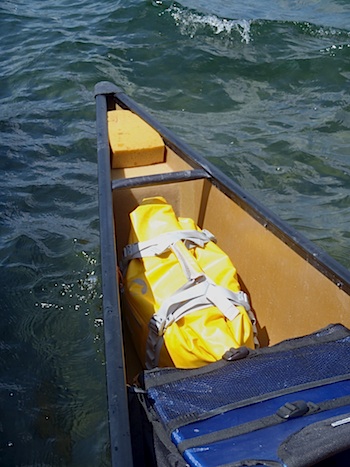Water in a national park, whether you're encountering the white-water variety, or a relatively smooth lake, or even pools of water while canyoneering, can wreak havoc on cameras and other electrical equipment. They need protection.
True, some point-and-shoot cameras can handle relatively short dives (say 20-30 feet), and there are water-proof cases you can place your camera in. But if your preference is to work with digital SLRs, you need to keep them out of the water. And Lowepro's new collection of DryZone bags can help you accomplish that task.
I had an opportunity to test the DryZone 20L bag (MSRP $149.99) during a five-day paddling trip to Yellowstone National Park. We put in at Lewis Lake, paddled across it to the Lewis River Channel, and followed that a few miles to Shoshone Lake. There we spent five wonderful days paddling and exploring this great backcountry destination.

The "torpedo" shape of the DryZone 20L made it easy to stow in the canoe's stern. Kurt Repanshek photo.
The DryZone bag came in handy as I was toting my Nikon D80 camera and three lenses. That took up less than half of the bag's capacity. So in went a small digital recorder, an Olympus Stylus Tough point-and-shoot, and a SPOT Global (satellite) Phone. And there still was a little room left for another lens or two. There's also a small zippered pocket on the outside for small items, such as keys or lip balm, but really not much more.
What I liked about these bags (there are also two backpack styles) is that they're rugged. The bags are made out of a dry-bag-like waterproof fabric carrying a Thermoplastic polyurethane coating. The 20L features an inner, removable, liner bag that securely nests your lens and cameras in padded compartments.
To protect your gear, you zipper the internal bag shut, compress out any excess air, fold the roll-top opening of the outer bag at least three times, and then buckle it closed via buckles on both the ends of the opening and straps across the top. Those top carrying stops are fully adjustible; if you wanted, you could cinch them down so they are flat across the bag's top and out of the way.
The 20L merits an IPX-6 waterproof rating, which basically means it can withstand a high-pressure stream of water from any direction. The rating does not, however, mean you can dunk the bag underwater and expect its contents to remain dry.
Fortunately, I wasn't involved in any dunking or canoe capsizing. But I was near the water daily, and at times winds kicked up small swells that spewed some water into the canoe and atop the DryZone 20L. The five days, however, convinced me that the bag was perfect for this sort of application.
On shore, the durable bag left me with no qualms about dirt or grit either getting into the bag or being embedded in the coated fabric. The bright yellow color also makes the bag hard to lose sight of.
In the past I've used hard-sided Pelican waterproof boxes for camera gear, and while they come in various sizes, they don't always easily fit into canoes as did the DryZone 20L. It slipped nicely into the very rear of my canoe behind my seat, thus keeping my cameras within arm's length, which came in handy for photographing mergansers we encountered in the Lewis River Channel. Its slender size would make it perfect for stowing away in a kayak, too.
The inner bag is designed to be removable if you want to carry your gear someplace where water isn't an issue. It can be a little tricky to remove against the coated waterproof fabric because its cut is so close to that of the outer bag. But then, my intended uses are fully focused on watery conditions, not pulling the interior bag out for hauling my gear.

Having my cameras close at hand enabled this shot of mergansers in the Lewis River Channel. Kurt Repanshek photo.
The DryZone 40L (MSRP $229.99) is a backpack with a somewhat larger capacity that would come in handy on canyoneering trips where you might need to cross pools of water or encounter waterfalls. Again, though, this pack carries an IPX-6 rating, which means dunking could jeopardize your gear.
If you're looking for something that can stand going underwater a few feet for a short time, consider the DryZone 200 (MSRP $329.99), a backpack Lowepro promotes as a "drysuit for your gear" that carries an IPX-7 rating, which means it can keep the contents dry for up to an hour under 3 feet of water.
But for canoe or kayak trips, the DryZone 20L is a great bag for protecting your gear.


 Support Essential Coverage of Essential Places
Support Essential Coverage of Essential Places







Comments
I have never canoed in a national park, but I have certainly hiked in the pouring rain more than once. Could you use the DryZone backpacks for other items as well as camera stuff if you thought it would pour on your hike? Or, would a regular, decent backpack plus poncho be good enough in those situations?
Steve, you likely could...though the 40L really isn't big enough for more than a dayhike. I don't think you could get enough gear into it -- tent, sleeping bag, food, etc. -- to use it for a backpacking excursion.
There are waterproof backpacks out on the market now -- Arc/teryx makes a few -- that would likely be more suitable. Though you'd have to figure out how best to cushion your camera gear within them.
Another option is to put a heavy duty garbage bag inside your packpack and stuff everything in it. I made a mistake once and put the garbage bag on the outside and brush tore it up.